
In the struggle for beauty, various means are used, such as fractional photothermolysis. This technology is very popular. It allows you to get rid of many cosmetic problems in a short time and with almost no pain. Before agreeing to the procedure, you need to familiarize yourself with the contraindications.
Fractional photothermal - what is it?
This procedure uses a laser. It in the process of heating the skin causes localized destruction of cells. During contact with it, the skin will suffer a thermal burn. The diameter of such lesions can vary from 0. 1 to 0. 4 mm, and the depth is 0. 5 mm. The burn is punctured. Such damage to the epidermis stimulates tissue regeneration and collagen synthesis.
Fraxel laser resurfacing does not destroy melanocytes. For this reason, dark-skinned people do not develop hypopigmentation spots after photothermolysis. In contrast, the laser promotes the redistribution of the pigment melanin, which lightens the skin. Fractional facial rejuvenation has the following benefits:
- can be used for both young skin (after 16 years old) and aging skin;
- have a wide range (eyelids, face, décolleté, etc. );
- lasting effect;
- can be held at any time of the year, including summer;
- Can be applied to any skin type.
Ablative fractional photothermal process
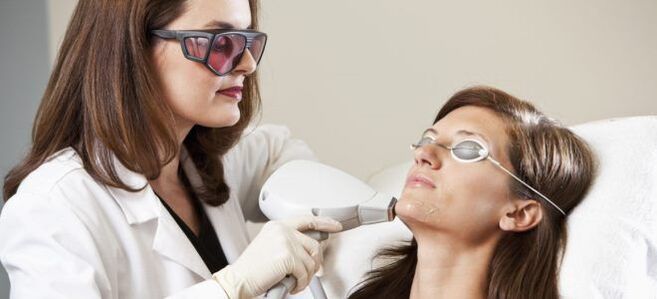
For this procedure, erbi and CO2 lasers are used. In contact with the skin, the fluid in the cells of the epidermis is heated up to 300 ° C. As a result, such areas evaporate, and in their place small open wounds are formed. formed, surrounded by thermal coagulation cells. The process of restoring these "zones" requires a lot of time. Such fractional laser resurfacing is performed in courses, each lasting from 2 to 6 sessions. It gives an amazing lifting effect. However, when it is done, the risk of infection of the skin tissues is high.
Non-ablation fractional photothermolysis
Compared with the dissection procedure, this operation is considered to be gentler. Such laser skin resurfacing using fractional CO2 lasers does not violate the integrity of the epidermis: no open wounds. The effect of such a procedure is less obvious than that of an ablative procedure, partly because the breakdown products are not removed to the outside but remain within the thickness of the skin. Laser fractional photothermolysis is recommended in courses, the duration of which can vary from 4 to 10 processes. When they are done, the risk of skin infection is reduced to zero.
Fractional photothermal - indication

This cosmetic procedure has a wide range of applications. Fractional photothermolysis treats scarring, but this is not its only purpose. This procedure helps to solve the following problems:
- increase skin tone and elasticity;
- against hyperpigmentation of the skin;
- remove solar keratosis;
- remove wrinkles;
- Shrink pores;
- helps to get rid of stretch marks on the body;
- Remove after acne.
Fractional photothermolysis - contraindications
Not everyone can enjoy the results of such a procedure. The following are contraindications for external photothermolysis:
- cancer;
- chronic diseases in the acute stage;
- skin diseases;
- inflammatory processes in the body;
- mental illness;
- hormone imbalance;
- pregnancy;
- lactation period;
- heart failure;
- blood diseases;
- Diabetes;
- infectious disease.
In addition, fractional photothermolysis is prohibited if mechanical dermabrasion has been performed recently (less than two weeks ago). After sunbathing and sunbathing, such procedures can also not be performed. High temperature and fever are contraindications for photothermolysis. It cannot be performed even if the integrity of the skin in the treatment area is violated.
Absolute contraindications to fractional photothermolysis are the following drugs:
- vitamin A;
- cytostatic drugs;
- glucocorticoids;
- immunosuppressive drugs.
Fraxel procedure
Partial skin rejuvenation should be performed by an experienced esthetician with extensive medical training. At the appointment, the specialist will objectively assess the skin condition and make sure there are no contraindications to the course. In addition, before performing a fraxel laser facial treatment, the esthetician will warn the patient about possible complications after photothermolysis. At the same time, the expert will surely tell you how to properly care for your face or body during the recovery period.
Fractional photothermal - preparation
It started 2 weeks before the recommended action. It can be divided into the following steps:
- Refuse to use cosmetics that are harmful to the skin. These include exfoliating and peeling. In addition, it is necessary to exclude salicylic and glycolic acids and retinol from use. Such restrictions take effect half a month before fractional photothermolysis.
- No visit to the solarium and beach is allowed one week before the procedure.
- 2-3 days before the procedure, you need to start taking antibiotics and antiviral drugs prescribed by a cosmetologist. Such medications will minimize the risk of inflammation or infection of the epidermis.
- The day before fractional laser resurfacing, you need to stop playing sports and other intense physical activities. The consumption of alcoholic beverages is also prohibited overnight.
Fractional laser resurfacing
The procedure takes about an hour. Its implementation is carried out in several stages. The fractional photothermal process of the face is carried out as follows:
- The esthetician cleans the patient's skin with a gentle peeling.
- The specialist applies anesthetic to the surface to be treated.
- After 40 minutes, the beauty begins to treat her facial skin with a special nozzle. At this point, the patient may feel a slight tingling. During this process, the skin is cooled by the flow of air, which helps reduce discomfort. The most problematic areas of the face are treated several times.
- A soothing cream is applied to the skin.
Fractional photothermolysis of the eyelids
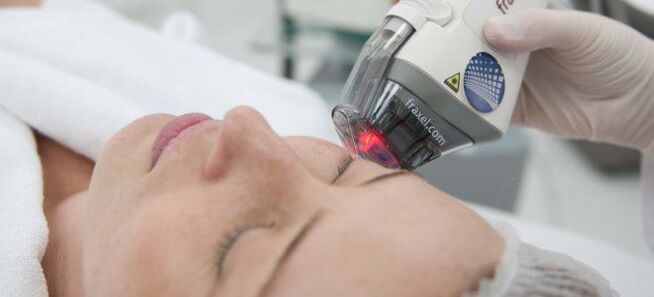
Because the skin around the eyes is very delicate and sensitive, the lowest power laser will be used to affect that skin area. The most commonly used device with erbium rods. Its maximum allowable wavelength is 1420 nm. Before starting to perform fractional photothermolysis of the eye, the esthetician puts on the patient special protective glasses. The procedure itself is performed in exactly the same way as for a facial or body treatment.
Fractional photothermolysis - side effects
This procedure is considered gentle. If the patient has previously taken antibiotics and anti-inflammatory drugs prescribed by a specialist and followed all recommendations, the risk of side effects is minimal. In addition, the skill of the esthetician depends on whether the fraxel rejuvenation procedure is accompanied by complications or not. The more experienced he is, the more professional the procedure will be and therefore the lower the risk of negative consequences.
Laser fractional photothermolysis is often associated with the following complications:
- swelling and redness in the treated area (ice will help to remove);
- peeling (remove with moisturizer);
- bronzing effect (maintained for 1-2 weeks).
If a skin infection occurs during fractional photothermolysis with an erbium laser, the following side effects may occur:
- streptococcal disease;
- erythema;
- bubbles (as after a burn);
- skin hyperpigmentation;
- rash.
Fraxel - rehabilitation
After the treatment, the skin needs special care. The duration of the recovery phase and the final effect depend on the observance of the cosmetologist's recommendations during this period. When using Fraxel, after the procedure, you must follow these instructions for skin care:
- Continue taking antibiotics and antiviral drugs according to the dose prescribed by the specialist for a certain period of time.
- If the procedure is performed by a man, you can only shave on the third day and this must be done very carefully.
- Within 48-72 hours after the operation, you must not play sports or do vigorous physical activity.
- It is necessary to give up drinking alcoholic beverages (this is a restriction for 2-3 days).
- During the month, visitors are not allowed to visit the solarium and the beach. On the treated skin area before going out, remember to apply a cream with a high sun protection factor.
- You cannot tear off the crust that has appeared on the skin! She must fall on her own.
- In the first weeks after the procedure, to care for the treated skin, it is necessary to use topical preparations indicated for thermal burns. Moisturizing spray will also be suitable during this period.
- For a month, it is recommended to give up chemical exfoliation and exfoliating.
Fractional photothermal - effect
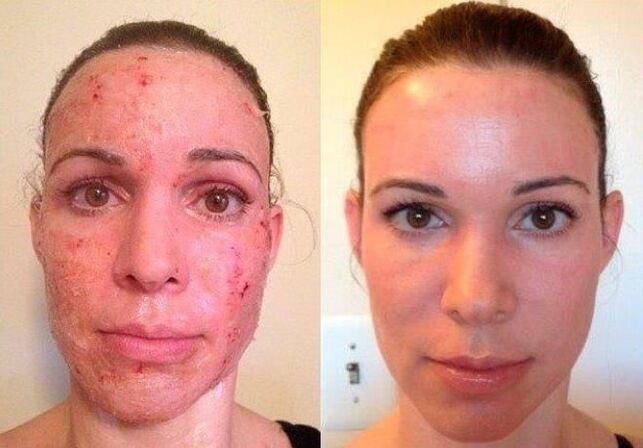
The first day, the skin will look as if it has been burned in the sun. The fractional photothermic images immediately after the procedure were not impressive. Recovery with a non-dissection type of manipulation occurs about 3-4 days. After the ablation procedure, this phase lasts about a week. Although even one workout improves the condition of the skin, it should not be limited. You need to go through the whole course: fractional photothermolysis before and after photography to convince you of this.
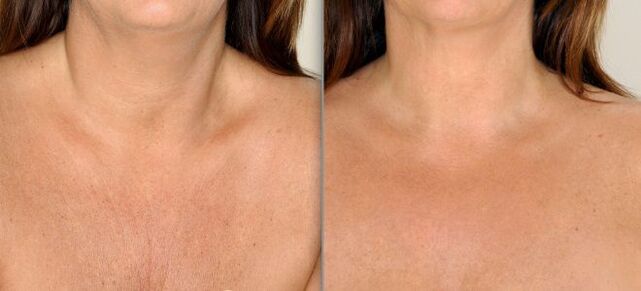
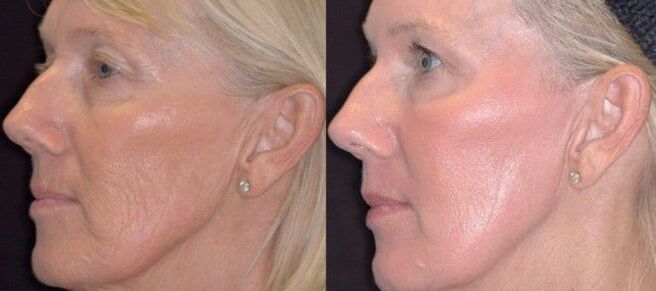
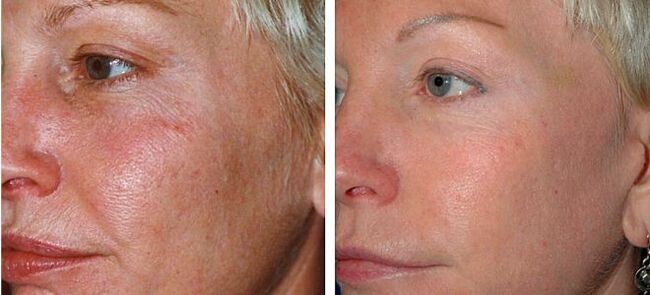
The duration of such therapy in each case is determined by the cosmetologist. The interval between individual manipulations is 4-5 weeks. The length of treatment depends on the problems to be solved:
- for rejuvenation, it is recommended to undergo 3-4 sessions;
- fractional photothermal process of the scar is represented by 6-8 procedures;
- To cope with problem areas of the skin, 5-6 sessions of pyrolysis are prescribed.


























